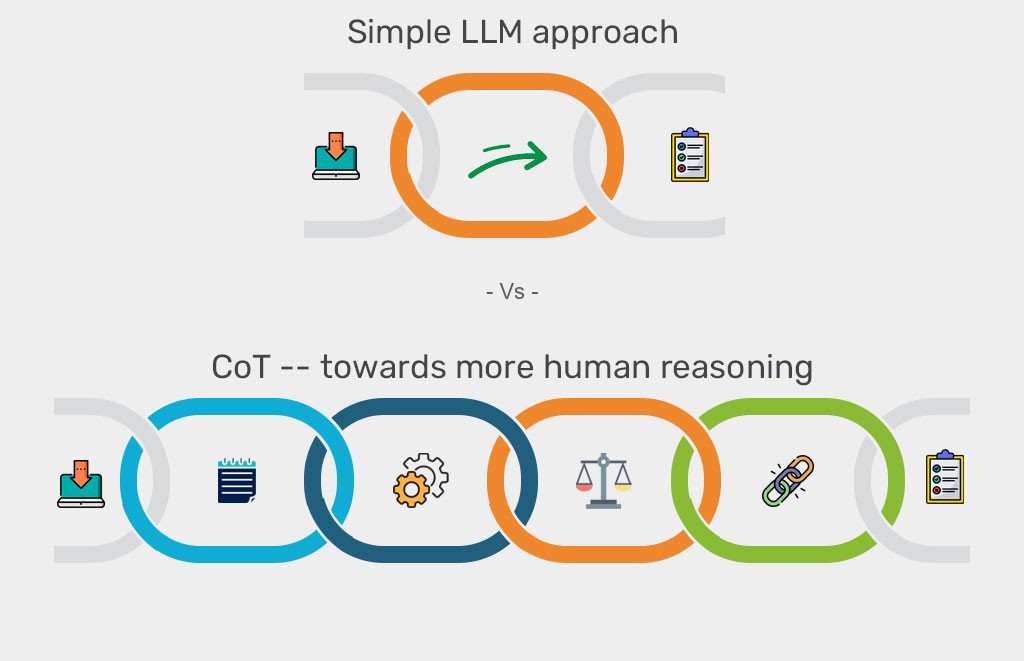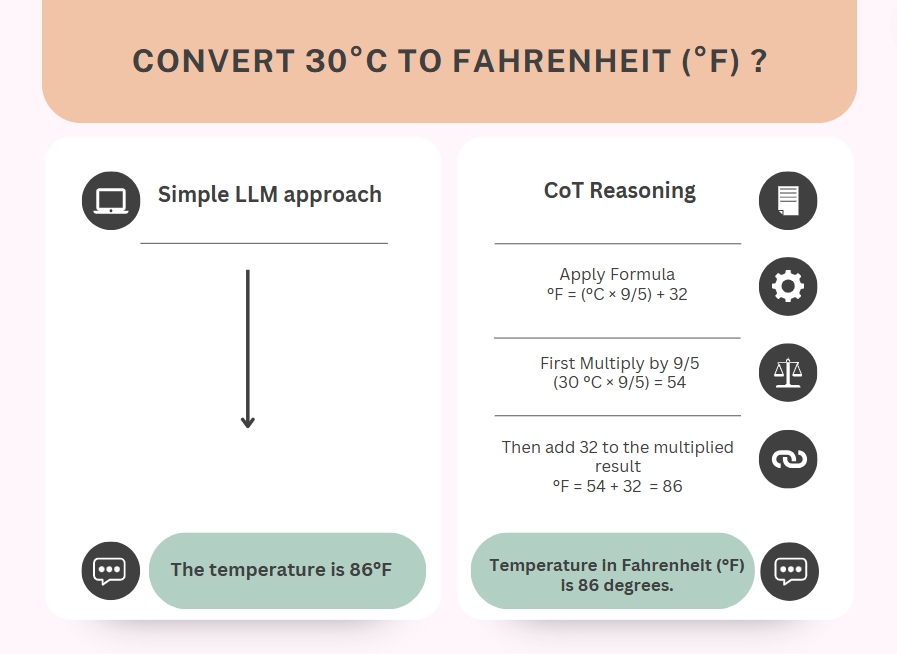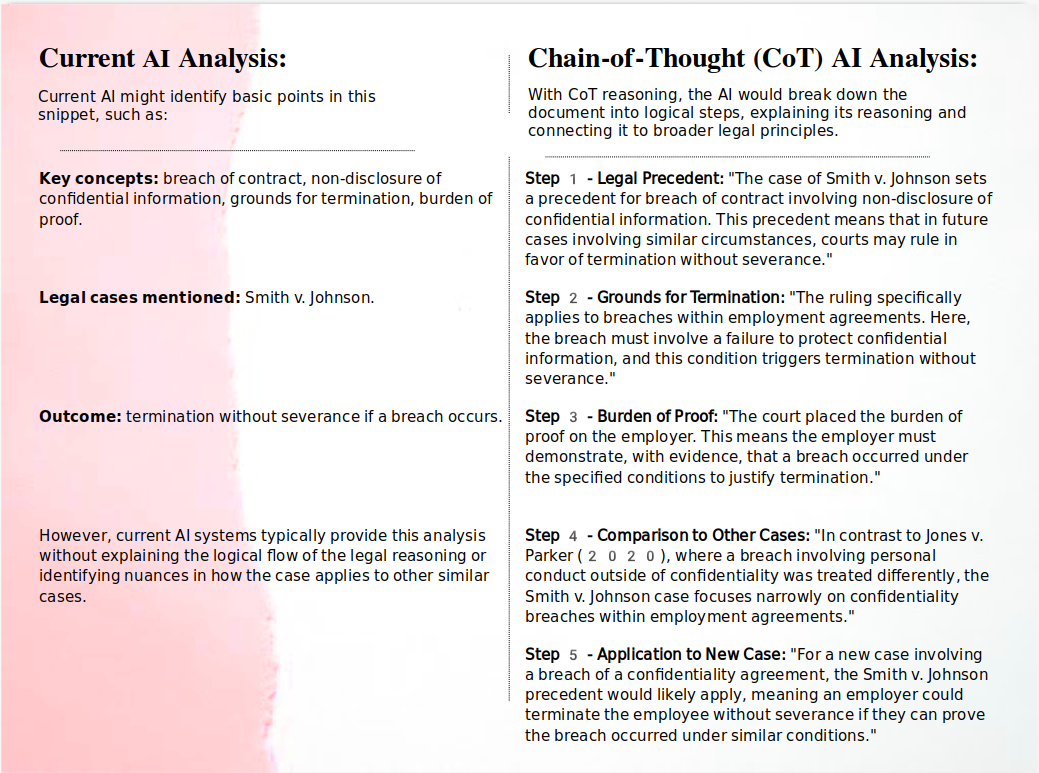
The recent release of the Open AI o1 model represents a significant leap forward in AI, particularly in its ability to mimic human reasoning. OpenAI reported that in a qualifying exam for the International Mathematics Olympiad (IMO), GPT-4 solved only 13% of the problems, while the o1 reasoning model scored an impressive 83%. In coding contests, o1 reached the 89th percentile in Codeforces competitions. These advancements signal a rapid evolution in AI capabilities. But what is driving these improvements? The key lies in Chain-of-Thought (CoT) reasoning.
What is Chain-of-Thought (CoT) Reasoning?
Chain-of-Thought reasoning closely mimics human problem-solving by breaking down complex tasks into smaller, sequential steps. Similar to how people “think out loud,” CoT enables AI models to link one reasoning step to the next, forming a structured and coherent flow of thought. This approach improves the model’s ability to reason more effectively and logically, particularly when faced with complex problems.
How Does CoT Work?
Traditional large language models (LLMs) often struggle with tasks requiring multi-step reasoning, as they are optimized for predicting the next word in a sequence rather than executing structured problem-solving. CoT reasoning changes that by helping models “think aloud” in a methodical, step-by-step manner:
- Step-by-Step Prompting: The model is encouraged to process each part of a problem individually rather than jumping straight to the conclusion.
- Generating Intermediate Steps: The AI breaks down problems into smaller, logical steps, such as identifying key data points or performing incremental calculations.
- Maintaining Coherence: Each step builds on the previous one, ensuring a consistent and logical chain of reasoning.
- Fine-Tuning with Examples: CoT is enhanced through fine-tuning, where the model is trained using examples that involve multi-step reasoning, improving its ability to replicate such processes in new tasks.
CoT in Action

This breakdown not only ensures accuracy but also provides transparency into the thought process.
The Impact of Chain-of-Thought (CoT) Reasoning
CoT reasoning significantly improves LLMs by enhancing their problem-solving abilities across various domains.
-
Improved Accuracy
One of CoT’s most impactful benefits is its ability to improve accuracy. By decomposing complex problems into smaller, more manageable steps, CoT minimizes errors that might occur in traditional models. In tasks requiring multi-step reasoning, such as mathematics or logical deductions, CoT enables the AI to handle each phase of the problem with greater precision, reducing the chances of errors that can propagate through one-shot solutions.
-
Increased Interpretability
CoT also enhances the transparency of AI decision-making. By showcasing each step of the reasoning process, users can understand how the model arrives at its conclusions. This transparency is invaluable in fields like healthcare, legal services, and finance, where understanding the reasoning behind AI recommendations is critical. For example, in medical diagnostics, CoT could not only suggest a diagnosis but explain the reasoning for it, enabling practitioners to verify its accuracy.
-
Generalization Across Domains
CoT reasoning enables models to generalize better across different tasks. Instead of being limited to specific types of problems, CoT allows AI to apply a structured problem-solving approach to unfamiliar tasks, such as switching from language-based tasks to complex mathematical or scientific domains. This adaptability makes CoT models more versatile across industries.
Example: In mathematics, a CoT-enabled model tasked with solving a complex algebraic equation would break the problem down into parts, solve for individual variables, and then combine these steps to arrive at the final solution. This method reduces error and increases accuracy.
Disruptions Ahead
Education is one area where CoT AI has the potential to significantly disrupt current life patterns. Imagine an AI tutor that can explain step-by-step solutions to complex problems, offer multiple methods to solve them, and allow students to ask questions at any point in the process. Such a system could revolutionize how education is delivered, tailoring lessons to individual learning styles and providing real-time feedback.
For instance, students struggling with math could interact with AI tutors that not only explain problems but also adjust their teaching methods based on the student’s pace. This would democratize education, giving every learner access to a personalized, world-class tutor, regardless of their location or background.

Another key disruption could emerge in workforce automation, particularly in creative and problem-solving professions. While AI is already automating routine tasks, CoT AI could introduce a new level of disruption by automating complex, reasoning-based tasks. In software development, for example, AI could debug code, explain logic errors, and even suggest improvements, freeing developers to focus on more strategic tasks. Similarly, CoT AI could reshape marketing and content creation by generating entire campaigns based on deep contextual understanding, effectively reducing the workload in creative fields.
A concrete example of this disruption can be seen in legal services, where CoT AI could assist with parsing documents, explaining legal precedents, and crafting complex arguments, saving professionals hours of research and enabling them to focus on more strategic decision-making.

Shortcomings of CoT
Despite its advantages, CoT reasoning comes with certain challenges:
- Higher Resource Demands: Breaking tasks into smaller steps requires more computational power, making CoT less efficient in some scenarios.
- Dependence on Well-Crafted Prompts: CoT reasoning is sensitive to the quality of prompts. Poorly designed prompts can derail the reasoning process, leading to incorrect conclusions.
- Challenges with Scaling: As task complexity increases, the number of reasoning steps grows, which can increase the likelihood of errors and make the process harder to manage.
- Risk of Overcomplication: In some cases, CoT may introduce unnecessary complexity, especially for straightforward tasks where a simpler approach would be more efficient.
- Limited Applicability: CoT shines in complex reasoning tasks, but its benefits diminish for simple problems where direct answers suffice.
Conclusion
Chain-of-Thought reasoning represents a major step forward in AI development, bringing models closer to human-like reasoning. By breaking tasks into logical steps, CoT enhances accuracy, transparency, and generalization across various domains. However, these advancements come with challenges, such as increased resource demands and dependence on prompt quality. Despite these limitations, CoT is poised to shape the future of AI, enabling more effective reasoning and greater accountability in decision-making processes.
About the Author
With over thirty years of experience bringing innovative products to market, Regi Roy, as CEO, provides leadership to all activities at Founding Minds. Regi has helped scores of companies rapidly develop their software products and bring them to market through the Incubator-In-A-Box program including core AI products. Regi has a passion for experimentation which he brings to bear on his varied hobbies ranging from cooking to gadget building to gardening.

